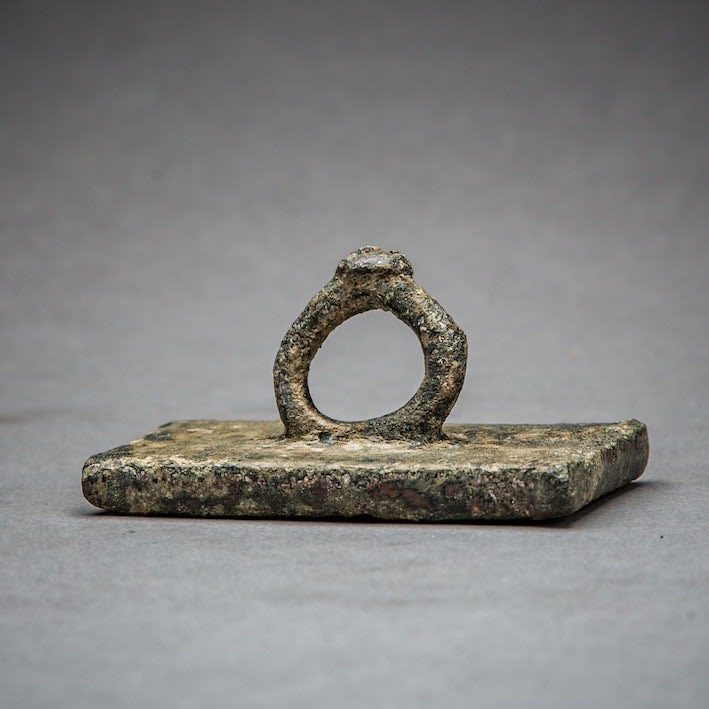Byzantine Bread Stamp, AD 500 - AD 900
Bronze
4.2 x 8.4 cm
1 5/8 x 3 1/4 in
1 5/8 x 3 1/4 in
OF.044
Further images
During the Roman Imperial period, bakeries were legally required to stamp their bread with an unique and non-reproduceable seal in order to trace the source of the loaves and prevent...
During the Roman Imperial period, bakeries were legally required to stamp their bread with an unique and non-reproduceable seal in order to trace the source of the loaves and prevent the theft of military rations and supplies for civilians. Upon the birth of the Byzantine Empire, bread stamps were still used, although their purpose had significantly changed. Stamps evolved in a myriad of forms, but they all followed the same trajectory of becoming associated with and utilised in religious ceremonies. There is huge variation in individual shapes and sizes in Byzantine stamps, but there are two main categories. For seals used in the Eucharist, the Holy Communion, one draws geometric patterns on the bread, segmenting and dividing the loaf using lines and quadrants, while the other is a much simpler design, marking the bread with religious symbology or an inscription. The first of the two types would form helpful guide-lines, indicating to the priest where to cut the bread during the Eucharist. As part of the Eastern Orthodox version of the communion ritual, the Divine Liturgy, the bread had to be baked by a recently confessed priest, who would stack two loaves together and stamp the top one. The resulting baked loaf, called prosphoron, would then be cut into several squares to be given to the faithful mass attendees. The centre of the bread loaf, a cube named the ‘Lamb’, usually where the stamp’s central design was still intact, was kept uncut. This was the piece which would be consecrated, taking on the qualities of the Body of Christ. The traditional stamp design which is still used currently bore the inscription IC XC NIKA, an abbreviation of ‘Jesus Christ conquers’. However, in Byzantine times the seal designs were much more free; square, round, cross-shaped or even shoe-shaped seals are often found, and draw upon Christian symbology to communicate religious and sacrosanct imagery and themes.
This particular bronze stamp is rectangular shaped. One must imagine that once baked, the inscription would enlarge, thus leaving a sizable portion for the Lamb. The inscription the seal bears reads murogenous in Greek script. Byzantine Greek lettering and dialect presents various differences compared to the Attic Greek traditionally studied by Classicists. For example, the capital Sigma, the last letter written here appears as what is referred to as a lunate Sigma, a common feature of Byzantine, but not Attic, Greek. One might also wonder why the stamp is not inverted, as using it would stamp the bread with inverted letters. In antiquity, the order of words and letters was a far less strict convention, with Greek text often being presented left, to right, right to left and at times a combination of both. Additionally, one must also keep in mind that the level of literacy would have been extremely low, thus the actual legibility of the stamp was negligible. The word murogenous means ‘one who originates sweet scents’ and relates to the Odour of Sanctity notion in Christianity. Christian belief states that saints, their stigmata, and various relics pertaining to sainthood, emanate sweet smells, often with notes of flowers, and maintain this quality in perpetuity. The Odour of Sanctity overcomes even death, as the bodies of saints are also believed to never rot and never smell, instead always emanating perfume.
This particular bronze stamp is rectangular shaped. One must imagine that once baked, the inscription would enlarge, thus leaving a sizable portion for the Lamb. The inscription the seal bears reads murogenous in Greek script. Byzantine Greek lettering and dialect presents various differences compared to the Attic Greek traditionally studied by Classicists. For example, the capital Sigma, the last letter written here appears as what is referred to as a lunate Sigma, a common feature of Byzantine, but not Attic, Greek. One might also wonder why the stamp is not inverted, as using it would stamp the bread with inverted letters. In antiquity, the order of words and letters was a far less strict convention, with Greek text often being presented left, to right, right to left and at times a combination of both. Additionally, one must also keep in mind that the level of literacy would have been extremely low, thus the actual legibility of the stamp was negligible. The word murogenous means ‘one who originates sweet scents’ and relates to the Odour of Sanctity notion in Christianity. Christian belief states that saints, their stigmata, and various relics pertaining to sainthood, emanate sweet smells, often with notes of flowers, and maintain this quality in perpetuity. The Odour of Sanctity overcomes even death, as the bodies of saints are also believed to never rot and never smell, instead always emanating perfume.
1
of
15







